JB Series
(JB-1 through JB-10)
The JB designation was introduced by the U.S. Army Air Force in 1943, and covered guided missiles with rocket and/or air-breathing jet (turbojet, pulsejet, ramjet) propulsion.
Northrop JB-1 Bat
In July 1944, Northrop received a contract to develop the JB-1 turbojet-powered flying bomb under project MX-543. Northrop designed a flying-wing aircraft with two General Electric B1 turbojets in the center section, and two 900 kg (2000 lb) general purpose bombs in enclosed "bomb containers" in the wing roots. To test the aerodynamics of the design, one JB-1 was completed as a manned unpowered glider, which was first flown in August 1944.
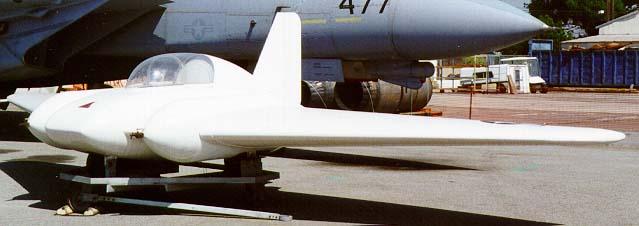 |
| Photo: Western Museum of Flight |
| JB-1 Glider |
In December 1944, the first JB-1 was ready for launch. The missile was launched by a rocket-propelled sled along a 150 m (500 ft) long track, but seconds after release the JB-1 pitched up into a stall and crashed. This was caused by an incorrectly calculated elevon setting for take-off, but the JB-1 program was subsequently stopped mainly because the performance and reliability of the turbojet engines were far below expectations. The program was reoriented towards pulsejet propulsion, and the remaining JB-1s were modified or completed as JB-10 missiles.
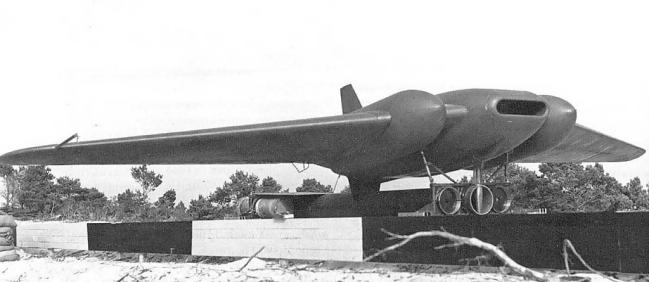 |
| Photo: Northrop |
| JB-1 |
Note: There are many references, which attribute the JB-1 designation specifically to the manned glider, and which call the unmanned bomb the JB-1A. However, official USAAF documents do not show any indication that a JB-1A designation was ever officially assigned, and therefore it must be assumed that JB-1 did indeed refer to the jet-bomb, and that the manned glider was simply called "JB-1 glider".
There was also a Northrop proposal for a significantly modified design, which Northrop called JB-1B, but this designation was also never officially allocated.
Willys-Overland JB-2
The JB-2 is discussed on a separate page about the LTV-N-2 Loon.
Hughes JB-3 Tiamat
The JB-3 Tiamat subsonic air-to-air missile program began in January 1944 under project MX-570. Prime contractor was Hughes who developed the Tiamat with the assistance of the NACA. JB-3 prototypes were initially launched from the ground with the aid of a booster and then from A-26 Invader aircraft. The JB-3 was propelled by a dual-thrust (boost/sustain) solid-fueled rocket motor and had three comparatively large wings with control surfaces for stability and control. The Tiamat used a semi-active radar seeker and the warhead was triggered by a proximity fuze.
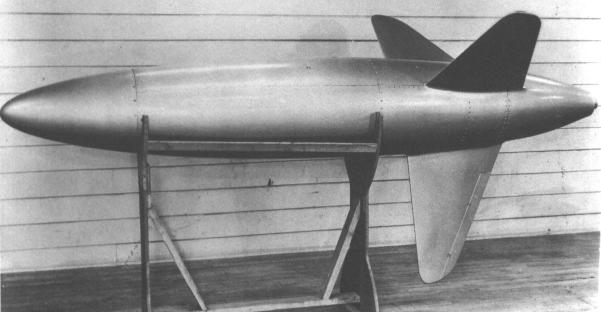 |
| Photo: USAF |
| JB-3 |
Testing and development of the JB-3 continued until after World War II, but in late 1946 or early 1947, the program was eventually terminated. By that time, more promising air-to-air missile projects had been started, notably the AAM-A-1 Firebird and AAM-A-2/F-98/GAR-1 Falcon.
JB-4
The JB-4, developed under project MX-607, was a basically a GB-4 guided glide bomb fitted with a Ford PJ31 pulsejet engine (the same type as used in the JB-2/LTV-N-2) to extend the standoff range to 120 km (75 miles). Like the GB-4, it was equipped with an AN/AXT-2 TV transmitter, sending its TV camera image to an operator in the launching aircraft, who could send radio commands to change the course of the missile. The JB-4 is reported as a surface-to-surface missile in some official records, so it seems that is was also intended for ground launch. The missile was tested in 1945, but the program was cancelled at the end of World War II.
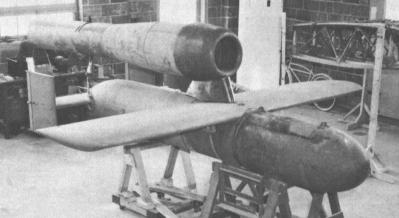 |
| Photo: via Ordway/Wakeford |
| JB-4 |
JB-5
The JB-5 (project MX-595) was to be an unguided air-to-surface rocket with a range of 6 km (3.7 miles). The baseline design called for a 385 kg (850 lb) rocket, consisting of a 225 kg (500 lb) general purpose bomb and 4 or 5 4.5-inch rockets as propulsion. Length was to be 3 m (10 ft) or less, and wingspan about 1.5 m (5 ft). A highly sensitive accelerometer was to ensure a straight-line trajectory after launch. Most likely, the program was cancelled before reaching the prototype construction stage.
JB-6
The JB-6 (project MX-600) was planned as a small high-speed air-to-surface rocket. Based on a standard 4.5-inch aircraft rocket, it was to have a weight of about 34 kg (75 lb) and a length of 1.4 m (54 in). Similar to the JB-5, the rocket was to follow a straight-line trajectory with the help of an accelerometer, gyros and aerodynamic surfaces. The warhead contained about 2.2 kg (5 lb) of explosives. Design studies were conducted by NACA and Hughes Aircraft, but the project was almost certainly cancelled before actual flight test hardware was built.
JB-7
The JB-7 (project MX-605) is described as a 4400 kg (9700 lb) turbojet-powered surface-to-surface cruise missile with a range of 640 km (400 miles). NACA had completed an airframe design with a length of 7.70 m (25 ft 3 in), a wingspan of 6.50 m (21 ft 4 in) and a diameter of 1.22 m (4 ft). Expected speed with a General Electric I-16 turbojet (later designated J31) was 560 km/h (350 mph). In early 1945, it was planned to build 25 experimental examples of this design, but this presumably never happened.
Interestingly, the USAAF reference [5] attributes the JB-7 designation to a project for a jet-powered high-speed research aircraft, which was cancelled when no suitable design came forward. However, given the scope of the JB-series and the description of the JB-7 in reference [6], this is definitely an error.
Boeing JB-8
The JB-8 designation was briefly assigned to the MX-606 project for a surface-to-air guided missile. It is described under its later designation SAM-A-1 GAPA (Ground-to-Air Pilotless Aircraft).
JB-9
The designation JB-9 was applied to a planned short-range rocket-propelled surface-to-surface missile with a 113 kg (250 lb) warhead. The design specifications called for a missile of around 3 m (10 ft) length, 1.8 m (6 ft) wingspan and 35 cm (14 in) diameter. The main propulsion was to be a rocket with 3 to 4 minutes burn time, giving the JB-9 a range of 16-24 km (10-15 miles) at a speed of 480-550 km/h (300-340 mph). The JB-9 was to be launched from a 9 m (30 ft) long truck-mounted ramp with the help 6 4.5-inch booster rockets. For guidance, a system similar to the JB-2 was planned, i.e. a radar beacon for tracking and radio-command guidance for directing. The JB-9 program had relatively low priority, and was cancelled before the design had been finalized. The JB-9 project is probably identical to project MX-626, which is documented as a "jet-propelled short-range surface-to-surface guided missile".
Northrop JB-10
After the JB-1 program had been terminated because of the failure of the turbojets, the remaining JB-1s were modified to a pulsejet-powered configuration, designated JB-10. A single Ford PJ31 pulsejet engine was mounted in a centerline shroud. The latter was of larger diameter than the pulsejet to allow the flow of cooling air around the engine. The prominent bomb containers of the JB-1 were also removed and replaced by integral warhead sections in the wing roots.
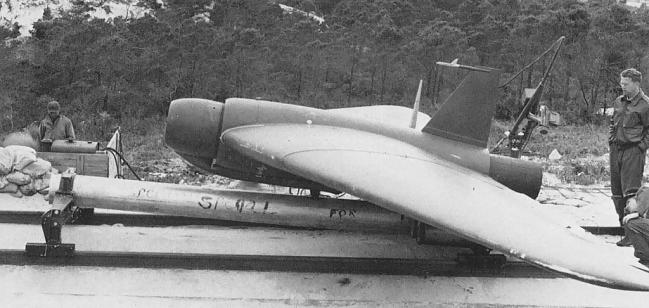 |
| Photo: Northrop |
| JB-10 |
Like the original JB-1 (and also the JB-2), the JB-10 was to be a low-precision standoff weapon for the planned invasion of Japan. The missile used a simple preset guidance system, where it would fly a predetermined distance into the direction of launch and then dive to the ground. The first flight of a JB-10 occurred in April 1945, but was not successful. In fact, of the 10 test-launches of JB-10s there were eight failures and two only partial successes. Because of the development problems (caused by several components of the system) and because the need for such a weapon had disappeared, the JB-10 program was terminated in January 1946.
Specifications
Note: Data given by several sources show slight variations. Figures given below may therefore be inaccurate!
Data for JB-1, JB-3, JB-4, JB-10:
| JB-1 | JB-3 | JB-4 | JB-10 | |
|---|---|---|---|---|
| Length | 3.21 m (10 ft 6.5 in) | 4.37 m (14 ft 4 in) | ? | 3.65 m (11 ft 11.6 in) |
| Wingspan | 8.64 m (28 ft 4 in) | ? | 3.6 m (12 ft) | 8.89 m (29 ft 2 in) |
| Height | 1.38 m (4 ft 6.4 in) | (n/a) | (n/a) | 1.47 m (4 ft 10 in) |
| Weight | 3210 kg (7080 lb) | 270 kg (600 lb) | 1360 kg (3000 lb) | 3270 kg (7210 lb) |
| Speed | 727 km/h (452 mph) | 965 km/h (600 mph) | 716 km/h (445 mph) | 685 km/h (426 mph) |
| Range | 1080 km (670 miles) | ? | 120 km (75 miles) | 300 km (185 miles) |
| Propulsion | 2x General Electric B1 turbojet; 1.8 kN (400 lb) each |
Dual-thrust solid-fueled rocket; 32 kN (7200 lb) / 0.9 kN (200 lb) |
Ford PJ31-F-1 pulsejet; 4.0 kN (900 lb) | |
| Warhead | 2x 900 kg (2000 lb) GP bomb | 225 kg (500 lb) high-explosive | 900 kg (2000 lb) high-explosive | 2x 825 kg (1825 lb) high-explosive |
Main Sources
[1] Garry R. Pape, John M. Campbell: "Northrop Flying Wings", Schiffer Publishing Ltd., 1995
[2] Fred Anderson: "Northrop. An Aeronautical History", Northrop, 1976
[3] Frederick I. Ordway III, Ronald C. Wakeford: "International Missile and Spacecraft Guide", McGraw-Hill, 1960
[4] Bill Gunston: "The Illustrated Encyclopedia of Rockets and Missiles", Salamander Books Ltd, 1979
[5] US Army Air Forces: "Army Aircraft Model Designations", 1946
[6] US Army Air Forces: "Guided Missiles: development Status and Availability", 1945
Back to Directory of U.S. Military Rockets and Missiles, Appendix 1
Last Updated: 19 April 2024